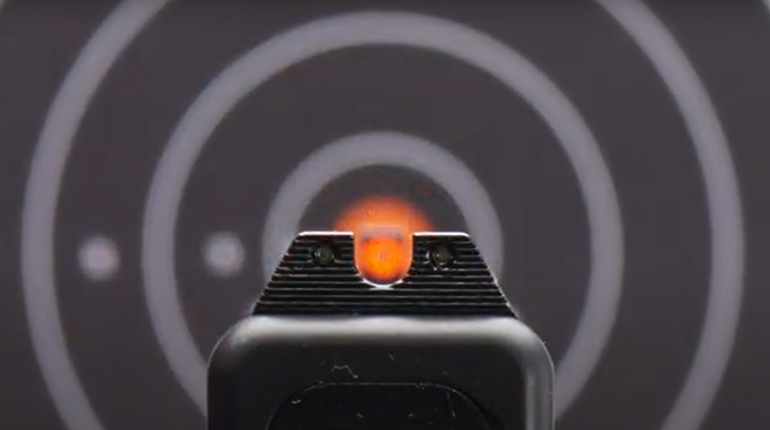

Just because a gunwriter, the military or some tactical guy on TV stipulates a 300-yard zero does not mean you have to follow suit. What if you're only going to shoot at 100 yards?
Depending on the ammunition, your trajectory can vary a great deal, showing extreme variations in point of impact (POI) in relation to point of aim (POA) at longer ranges. If you plan on employing your AR as a battle rifle, the Maximum Point Blank Range (MPBR) method has merit. The premise is being able to hold on your target over the longest distance possible and still get hits. MPBR depends primarily on two things; target size and trajectory.
For example, the Black Hills 69-grain Sierra MatchKing load produces 2,702 fps from my Del-Ton AR with a 16-inch barrel. If I specify an 8-inch target, my Sierra Infinity ballistics program tells me the MPBR for that load, at that velocity, is 296 yards. This means the bullet should not rise or fall above or below the line of sight (LOS) more than 4 inches from the muzzle out to 296 yards.
Switch to the Hornady 40-grain V-Max with a velocity of 3,342 fps and the MPBR changes to 330 yards. What's interesting is, to achieve a MPBR zero for the 69-grain load, I'd zero at 33 yards. For the 40-grain V-Max, I'd zero at 39 yards. Experience has shown that sighting-in somewhere between 30 and 40 yards will generally produce a MPBR for an 8-inch target with most .223 Rem. loads from an AR.
The problem with an 8-inch target MPBR zero is your rifle will be shooting about 3 inches high at 100 yards. If that's OK and you can hold to make the correction, no worries. If you want your 100-yard POA/POI to be the same, zero at 100 yards. Just remember, if you zero at 100 yards, you'll be a foot or more low at 300 yards, depending on your ammunition of course.
AR carbines are often employed at very close range. If you're keeping one for home defense, you need to be able to deliver accurate fire up close. Because the sights are about 2.5 inches above the bore, your bullet will strike about 2 inches below your POA inside of 10 yards. If you are trying to shoot a werewolf in the head across your living room, this could get tricky.

A solution is the XS Sight Systems CSAT sight. It has a notch in the top of the rear, small aperture. Up close, aim with the notch, not the aperture. This sight also has another useful feature. Most AR rear sights have two apertures: a large one for shooting from 0 to 200 yards and a small one for 300 yards and beyond. The centers of these apertures are offset as much as .025 inch, depending on barrel length. The XS CSAT sight does away with the offset, making the large aperture for low light and/or fast shooting at any range and the small aperture for precision shooting or for use in bright light at any range.
The military and most tacticians suggest a 300-yard zero with the small aperture when using conventional sights. With most loads, a 25-yard zero will get you close to a 300-yard zero because the bullet will cross the LOS at 25 yards and again at about 300 yards.
Regardless of the zero method you use, here are some tips to help you through the actual process. Set the sights to mechanical zero. For the front sight, this means turning it until the base of the post is level with the sight housing. For the rear sight, move the windage adjustment knob until the aperture is in the center of the housing. If the rear sight is of the A2 style, set the dial to either the 6/3 or 8/3 position.
Now, fire a three-shot group at a close target—generally something between 25 and 40 yards, depending on the zero you desire. If you are trying to establish a 100-yard zero, your POI should be about 1.5 inches below your POA at 25 yards. If you have a rear sight adjustable for windage and elevation, you can use it to move your POI to match your POA. If you have a rear sight with a range indicator like the A2 style sight, adjust elevation with the front sight.

When making sight adjustments, remember you move the rear sight the direction you want the bullet to move to match your POA. When adjusting the front sight, the opposite applies. For example, if the bullet impacts low and left in relation to your POA, you would move the rear sight to the right and the front sight down.
The click value for the sights will vary with barrel length. Generally you can expect each windage click to move the POI between .5 and .75 MOA. Each click of the front sight will move the POI between 1.5 and 2.0 MOA. For all practical purposes 1 MOA equals 1 inch at 100 yards (or .25 inch at 25 yards).
Once zeroed at close range, confirm and adjust at the longer zero range. If you're using the MPBR zero, you'll need a ballistics program to give you the exact zero range. Alternatively, you can guess. With an 8-inch target as a basis for your MPBR, your long-range zero will be close to 250 yards depending on the ammo used.
The most important thing when zeroing the iron sights on your AR is to establish a zero you can work with; one that will compliment the type of shooting for which you intend.




































